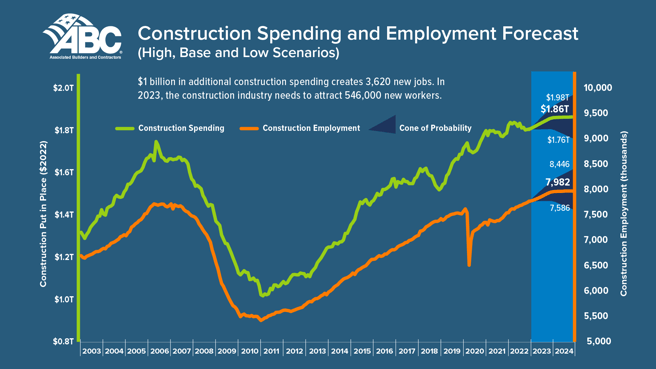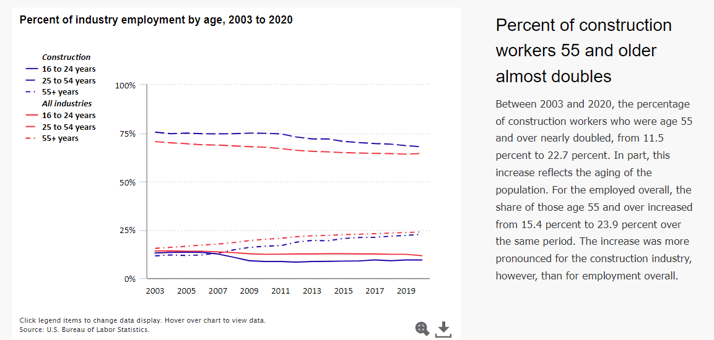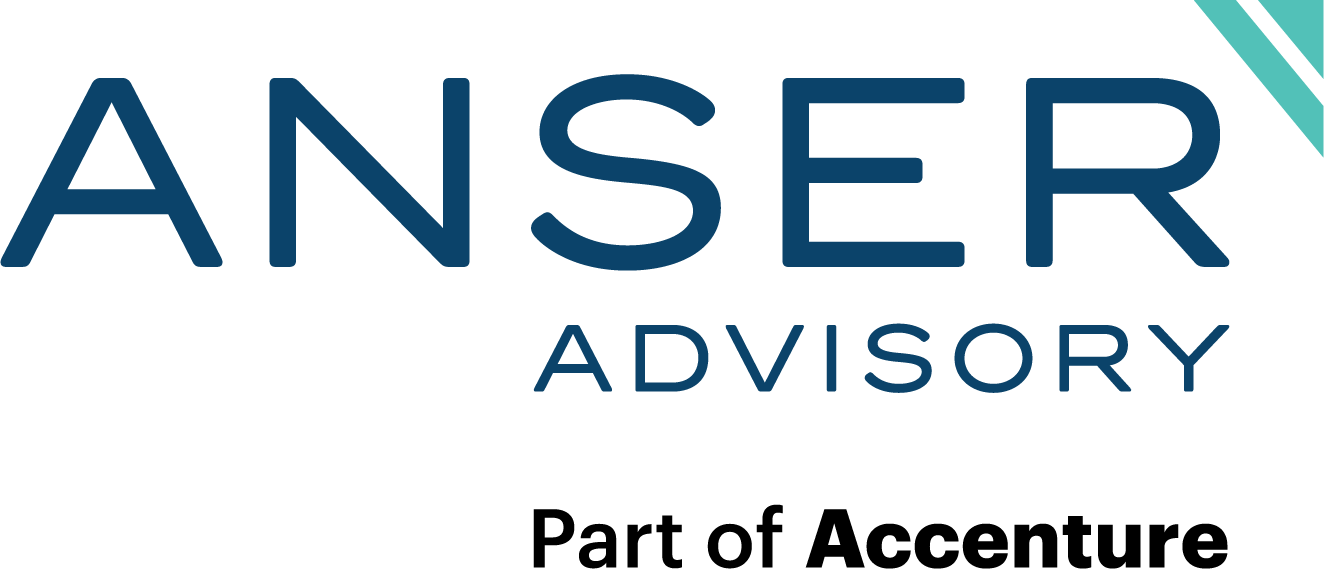As skills shortages across construction industry disciplines create challenges in filling open positions, industry leaders must lean into comprehensive solution options to upskill and reskill current and future talent. The construction industry comprises of not only craft and trades laborers but administrative and management occupations as well. In 2020, construction and extraction occupations (such as construction laborers, carpenters, and electricians) accounted for about three-fifths of those employed in the construction industry, while another one-fifth were employed in management, business, and financial operations occupations. Installation, maintenance, repair, and office and administrative support occupations accounted for 5.7 percent and 5.1 percent, respectively. According to modeling by the Associated Builders and Contractors, the construction industry needed to attract an estimated 546,000 additional workers on top of the normal hiring pace in early 2023 to meet the demand for labor. Those vacancies were still high by November 2023, according to the January 2024 U.S. Bureau of Department of Labor and Statistics report, which noted 459,000 construction job openings in the U.S. Filling these roles with skilled professionals is vital to America’s economy and infrastructure rebuilding initiatives. While federal funding was provided through the Infrastructure Investment and Jobs Act to focus on roads, bridges, and transit systems, these projects require skilled and qualified workers to move forward.
 "Construction Workforce Tops Half a Million," ABC
"Construction Workforce Tops Half a Million," ABC
The construction industry averaged more than 390,000 job openings per month in 2022, the highest level on record, and the industry unemployment rate of 4.6% in 2022 was the second lowest on record, higher than only the 4.5% unemployment rate observed in 2019. National payroll construction employment was 231,000 higher in December 2022 than in December 2021. Impacts from the 2020 pandemic continue to linger, with prospects of higher pay and remote work tempting experienced workers away from construction and into these and other sectors. According to Julia Pollak, an economist at ZipRecruiter, the number of people actively applying for construction jobs online fell about 40% between 2019 and 2020 and has been flat ever since.
While the pandemic only complicated existing workforce issues, other factors include mega projects from chip manufacturing plants, clean energy facilities, and infrastructure projects, which demand qualified workers at scale. Additionally, skilled workers are aging, creating concerns about future pipeline talent. Fewer workers are entering the skilled trades, meaning this is a construction labor and a skills shortage.
Between 2002 and 2020, the percentage of construction workers over 55 nearly doubled, from 11.5% to 22.7%. According to ABC Chief Economist Anirban Basu, “With nearly 1 in 4 construction workers older than 55, retirements will continue to whittle away at the construction workforce. Many older construction workers are also the most productive, refining their skills over time. The number of construction laborers, the most entry-level occupational title, has accounted for nearly 4 out of every 10 new construction workers since 2012. Meanwhile, the number of skilled workers has grown much slower or, in the case of certain occupations like carpenter, declined.”
 "The Construction Industry: Characteristics of the Employed, 2003–20", US BLS
"The Construction Industry: Characteristics of the Employed, 2003–20", US BLS
With this in mind, how are organizations working to recruit, upskill, and reskill this workforce?
Shifts to Skills-based rather than Credential-based Workforce Alignment
Skills-based practices can help employers draw from a wider pool of qualified candidates by focusing on the skills a candidate has more than their credentials and using inclusive language in job postings. Although credentials are significant achievements that often help verify someone's experience and competency, adding skill-based practices to existing screening methods can increase perspective. Employers can first create a skills framework for all positions by defining the required skills rather than preferred competencies and partnering with community associations that provide workforce support to reach potential candidates. Shifting from credential-based to skill-based recruitment is catching on. Large companies have signed on to the Rework America Alliance, the Business Roundtable’s Multiple Pathways program, and the Tear the Paper Ceiling campaign, pledging to implement skills-based practices. So far, they’ve removed degree requirements from certain job postings and have worked with other organizations to help workers progress from lower to higher-wage jobs.
This shift comes with great potential benefits. Hiring for skills is five times more predictive of job performance than hiring for education and more than two times more than hiring for work experience. Workers without degrees also tend to stay in their jobs 34 percent longer than workers with degrees. A skills-based approach allows employers to find great matches and retain them when it is historically difficult to do so. Moreover, it provides a road map for workers to make advancements internally, allowing employees to progress within their current companies when external hiring could slow down. There is an untapped opportunity for internal skills-based job progressions for workers. While some organizations face challenges in developing processes to evaluate a candidate’s proficiency in certain skills through interview questions or assessments, connections between industry partners can open up discourse and help drive new approaches.
On-the-Job Training and Apprenticeships
More and more organizations and agencies are looking to on-the-job training and apprenticeships to ensure the right skills and experience are developed in current and future workforce employees. Some states are even passing regulations to cement the existence of these programs. For instance, the Departments of Transportation (DOT) in Arizona and California now require that DOT-funded projects meet minimum targets for on-the-job training. Last year, California announced that it would invest over $231 Million in Advancing Apprenticeship, which aims to expand the state’s number of apprentices to a half-million by 2029. Findings from McKinsey’s recent American Opportunity Survey demonstrate the depth of appetite for reskilling in the industry. Fifty-eight percent of workers across the construction value career plans to pursue future training, education, or credentialing opportunities, 17 percentage points higher than the national average. These hands-on growth opportunities can help meet these needs and goals.
Training and Recruiting Programs for Younger Talent
The construction industry’s workforce shortage will require upskilling and reskilling existing workers and focusing on the future talent pipeline. Private and federal entities are looking to build stronger connections to younger talent, aligning themselves with middle school and high school programs to expose and educate talent that might not have otherwise considered these industry careers. This will require partnerships across industries and sectors to reach younger talent earlier. For instance, LIUNA, the Laborers’ International Union of North America, has efforts underway to reach more potential workers. LIUNA Training's LEARN Program is the only innovative four-year Career and Technical Education High School curriculum and recently partnered with San Antonio ISD to create the district's first pre-apprenticeship program. Students receive applied academic, work, and life skills that provide them with a solid foundation to enter a U.S. Department of Labor-recognized apprenticeship program and a successful career as a Construction Craft Laborer.
Shift Workforce Gaps into Opportunities
Focusing on mobilizing historically underutilized and underserved demographics may help to pull in and keep additional talent. As organizations look to revamp the construction workforce, they must be prepared to establish and support programs aimed at leveraging existing skills and growth potential within untapped talent in underserved demographics. While women are half the workforce, they make up only a small portion of the trades workforce. In 2020, women accounted for 1.2 million of those employed in the construction industry, or about 1 in 10, similar to recent years. Across the country, programs exist to help prepare and train groups that might have previously been overlooked. Historically, groups like the Boston Policy Group on Tradeswomen’s Issues noted that the previous 30 years of recruiting and training women had failed partly because it was a supply-only strategy; there needed to be work on the demand front.
About Anser's Training Services
Anser Advisory offers the Professional Construction Management Course™ and the Construction Management Principles Course™ courses to prepare new and current construction professionals for challenges and situations they will face in the field.
About the Author
Rachel Hanigan, CQA, CSSYB
Rachel Hanigan leads Anser's Training Solution and has over 12 years of experience in project and program management across complex domestic and international organizations, including the National Institutes of Health and Department of State Diplomatic Security and Overseas Building Operations bureaus. Rachel is responsible for the strategic planning, execution, and development of the organization’s training services and training brand. She has led internal, corporate-wide consultant training programs and now oversees the buildout of external training offerings and capabilities. She is experienced in Learning Management System (LMS) implementation and oversight, instructional design and development, e-learning course authoring, and training strategy and delivery. Rachel leverages innovative instructional delivery methods and data analytics to drive optimal learning results and program success. She holds a Bachelor of Arts in International Relations from the University of Mary Washington.


